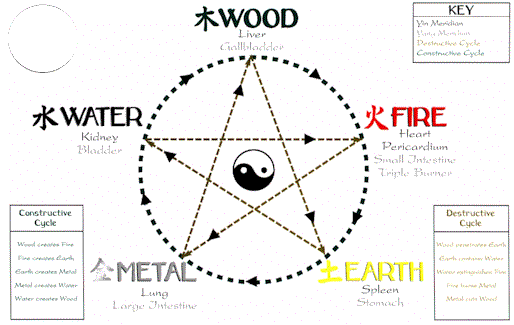
Five Element Diagram
|
As can be seen from the diagram ~ the following relationships occur.
These are a continuous "loop" and it is the disruption of this loop in its various forms that we as Martial Artists hope to achieve.
There are two Cycles that we can disrupt ~ The Constructive Cycle and the Destructive Cycle.
The Constructive Cycle is the outer ring, the Destructive Cycle being the inner Pentagon.
| Constructive | Destructive |
| Fire Feeds | Fire Melts |
| Earth ~ Which Feeds | Metal ~ Which Cuts |
| Metal ~ Which Feeds | Wood ~ Which Penetrates |
| Water ~ Which Feeds | Earth ~ Which Blocks |
| Wood ~ Which Feeds | Water ~ Which Puts out |
| Fire ~ And so on | Fire ~ And So on |
From our previous studies we also know the following;
Therefore we can now begin to add our Five Element knowledge to our Yin / Yang knowledge which also incorporates of course, the Quadrant Theory.
This all sounds so difficult ~ how can we possibly think of all this and more in a combat situation!?
The answer lies in Kata and practice and more practice. Kata, maps out where these points are, how to hit them, the best order in which to hit them, where your opponent will fall, how he will fall, where to follow up your strike and how. All of this information and more is contained in each and every move of each and every one of your Kata.
The next step is to understand how to interpret these moves. This is where the Open Circle Institute can help the Martial Artist. We have developed courses and Seminars specifically to understand Kata and its real applications. These Courses are designed as a true learning aid, we will give you the keys to unlock the secrets hidden within Kata. There is no mysticism in this, no hocus pocus, just clear guidelines and principles that work.
Just take the time for a moment to think of a Kata move. Maybe it is a move with a high grab and a low kick (opposites again), or a double strike ~ high left, low right (opposites again). To learn how to incorporate this come along to one of our Introductory Seminars.